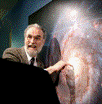Authors
I. Wanders, Ohio State University, Columbus, Ohio
Bradley M. Peterson, Ohio State UniversityFollow
D. Alloin, Centre dÏEtudes de Saclay, Service dÏAstrophysique, Orme des Merisiers, 91191 Gif-sur-Yvette Cedex, France
T.R. Ayres, University of Colorado, Boulder
J. Clavel, ISO Project, European Space Agency, Madrid, Spain.
D. Michael Crenshaw, NASA Goddard Space Flight CenterFollow
K. Horne, School of Physics and Astronomy, University of St. Andrews, North Haugh, St. Andrews, Scotland, United Kingdom
Gerard A. Kriss, The Johns Hopkins UniversityFollow
Julian Henry Krolik, Johns Hopkins UniversityFollow
Matthew A. Malkan, University of California, Los AngelesFollow
Hagai Netzer, Tel Aviv UniversityFollow
Paul T. O'Brien, University of LeicesterFollow
G.A. Reichert, NASA Goddard Space Flight Center, Greenbelt, MD
P.M. Rodriguez-Pascual, ESA IUE Observatory, Madrid, Spain
W. Wamsteker, ESA IUE Observatory, Madrid, Spain
T. Alexander, Max-Planck-Institut fuŽ r extraterrestrische Physik, Garching, Germany
K. S.J. Anderson, New Mexico State UniversityFollow
E. Benitez, Universidad Nacional Autonoma de Mexico, Instituto de Astronomia, Mexico
N.G. Bochkarev, Sternberg Astronomical Institute, University of Moscow, Moscow, Russia
A.N. Burenkov, Special Astrophysical Observatory, Russian Academy of Sciences, Nizhnij Arkhyz, Karachaj-Cherkess Republic, Russia
F.-Z. Cheng, Center for Astrophysics, University of Science and Technology, Hefei, Anhui, PeopleÏs Republic of China
S.J. Collier, School of Physics and Astronomy, University of St. Andrews, North Haugh, St. Andrews, Scotland, United Kingdom
A. Comastri, Osservatorio Astronomico di Bologna, Via Zamboni, Bologna, Italy
M. Dietrich, Landessternwarte, KoŽ nigstuhl, Heidelberg, Germany
D. Dultzin-Hacyan, Universidad Nacional Autonoma de Mexico, Instituto de Astronomia, Mexico
B.R. Espey, Department of Physics and Astronomy, The Johns Hopkins University, Baltimore, MD
A. V. Filippenko, University of California, BerkeleyFollow
C. Martin Gaskell, University of Nebraska-LincolnFollow
I.M. George, Laboratory for High Energy Astrophysics, NASA Goddard Space Flight Center, Greenbelt, MD
M.R. Goad, Space Telescope Science Institute, Baltimore, MD
L.C. Ho, Harvard-Smithsonian Center for Astrophysics, Cambridge, MA
Shai Kaspi, Tel Aviv UniversityFollow
W. Kollatschny, UniversitaŽts-Sternwarte GoŽttingen, GoŽttingen, Germany
Kirk T. Korista, University of KentuckyFollow
Ari Laor, Technion, Haifa, IsraelFollow
G.M. MacAlpine, Department of Astronomy, University of Michigan, Dennison Building, Ann Arbor, MI
M. Mignoli, Osservatorio Astronomico di Bologna, Via Zamboni 33, Bologna, Italy
S.L. Morris, Dominion Astrophysical Observatory, Victoria, B.C., Canada
K. Nandra, Universities Space Research Association
S. Penton, Center for Astrophysics and Space Astronomy, University of Colorado, Boulder, CO
Richard William Pogge, Ohio State UniversityFollow
R.L. Ptak, Department of Physics and Astronomy, Bowling Green State University, Bowling Green, OH
J.M. Rodriguez-Espinoza, Instituto de Astrofisica� de Canarias, Tenerife, Spain
M. Santos-Lleo, LAEFF, E-28080 Madrid, Spain
A.I. Shapovalova, Special Astrophysical Observatory, Russian Academy of Sciences, Nizhnij Arkhyz, Karachaj-Cherkess Republic, Russia
J.M. Shull, Joint Institute for Laboratory Astrophysics, University of Colorado, and National Institute of Standards and Technology, Boulder, Colorado
Stephanie A. Snedden, University of Nebraska-LincolnFollow
L.S. Sparke, Department of Astronomy, University of Wisconsin, Madison, WI
G.M. Stirpe, Osservatorio Astronomico di Bologna, Via Zamboni 33, Bologna, Italy
W.-H. Sun, Institute of Astronomy, National Central University, Chung-Li, Taiwan, Republic of China
T.J. Turner, Laboratory for High Energy Astrophysics, NASA Goddard Space Flight Center, Greenbelt, MD
M.-H. Ulrich, European Southern Observatory, Karl Schwarzschild Strasse 2, Garching, Germany
T.-G. Wang, Center for Astrophysics, University of Science and Technology, Hefei, Anhui, PeopleÏs Republic of China
C. Wei, Harvard-Smithsonian Center for Astrophysics, Cambridge, MA
W.F. Welsh, McDonald Observatory and Department of Astronomy, University of Texas, Austin, TX
S.-J. Xue, Center for Astrophysics, University of Science and Technology, Hefei, Anhui, People's Republic of China
Z.-L. Zhou, Beijing Astronomical Observatory, Chinese Academy of Sciences, Beijing, People's Republic of China
Date of this Version
11-1-1997
Abstract
From 1996 June 10 to July 29, the International Ultraviolet Explorer monitored the Seyfert 1 galaxy NGC 7469 continuously in an attempt to measure time delays between the continuum and emission-line fluxes. From the time delays, one can estimate the size of the region dominating the production of the UV emission lines in this source. We find the strong UV emission lines to respond to continuum variations with time delays of about 2.d3-3.d1 for Lyα, 2.d7 for C IV λ1549, 1.d9-2.d4 for N IV λ 1240, 1.d7-1.d8 for Si IV λ 1400, and 0.d7-1.d0 for He II λ1640. The most remarkable result, however, is the detection of apparent time delays between the different UV continuum bands. With respect to the UV continuum flux at 1315 Å, the flux at 1485 Å, 1740 Å, and 1825 Å lags with time delays of 0.d21, 0.d35, and 0.d28, respectively. Determination of the significance of this detection is somewhat problematic since it depends on accurate estimation of the uncertainties in the lag measurements, which are difficult to assess. We attempt to estimate the uncertainties in the time delays through Monte Carlo simulations, and these yield estimates of ~0.d07 for the 1 σ uncertainties in the interband continuum time delays. Possible explanations for the delays include the existence of a continuum-flux reprocessing region close to the central source and/or a contamination of the continuum flux with a very broad time-delayed emission feature such as the Balmer continuum or merged Fe II multiplets.



Comments
Published in THE ASTROPHYSICAL JOURNAL SUPPLEMENT SERIES, 113:69-88, 1997 November. Published by University of Chicago Press; Copyright 1998. Used by permission. HREF="http://www.journals.uchicago.edu/"http://www.journals.uchicago.edu/